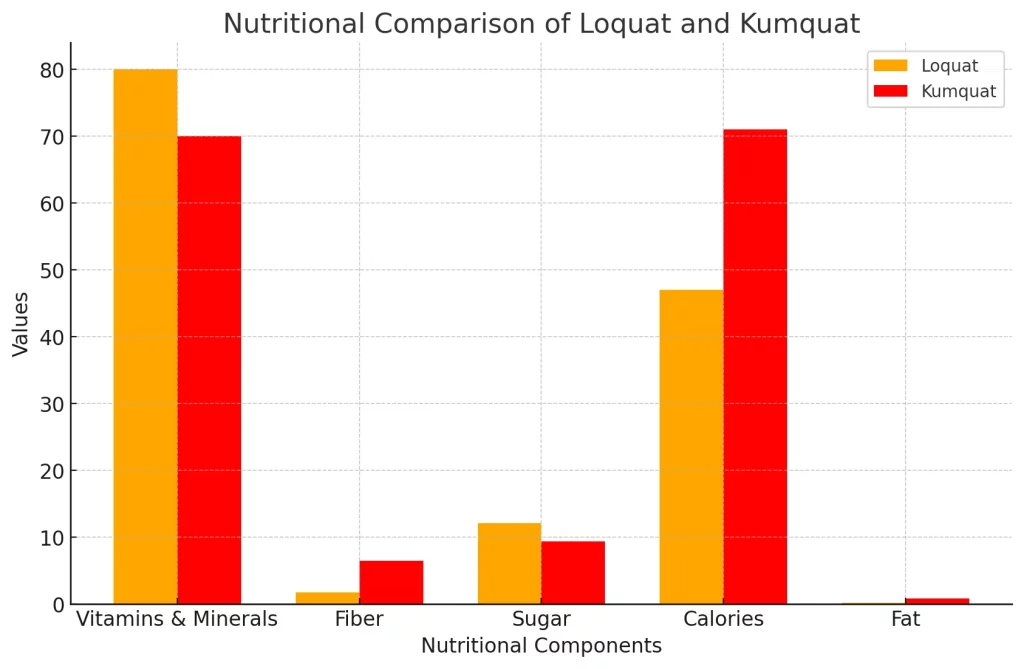Difference Between Loquat And Kumquat
Embark on a flavorful journey to uncover the difference between loquat and kumquat — two fruits that confuse with their names but delight with their distinct tastes! This article peels away the mystery, presenting you with a digestible comparison that’s as easy to understand as it is intriguing.
🌟 Quick Peek: Loquat vs. Kumquat
| Feature | Loquat | Kumquat |
|---|---|---|
| Family | Rosaceae (related to roses) | Rutaceae (citrus family) |
| Taste | Sweet with a tart undertone | Tangy with a sweet rind |
| Size | Larger, resembling apricots | Small, olive-sized gems |
🚀 Ready, Set, Explore! Dive into the juicy details as we compare these fruits not just in name, but in flavor, use, and growth. Whether you’re a culinary explorer or a home garden enthusiast, get set for an enlightening read.
📝 Note: Next time you’re at the market, why not give these fruity wonders a try? Each offers a unique twist to your fruit bowl!
Prepare for a read that’s as enriching as the vitamins packed in these natural treats. Let’s get started!
🌟 Quick Difference Between kumquat and loquat
| Feature | Loquat | Kumquat |
|---|---|---|
| Family | Rosaceae | Rutaceae |
| Origin | Central-Eastern China | Asia |
| Size | 1–2 inches (round, pear-shaped, or oval) | 1 inch (oval or round) |
| Skin | Yellow to bronze, tough | Golden-orange, sweet, and edible |
| Flesh | White or orange, juicy | Bright citrusy, firm |
| Flavor | Sweet with a hint of tartness, like a blend of various fruits | Sweet rind with a tangy, sour flesh |
| Cultivation | Larger tree, up to 25 feet, less sun and maintenance | Smaller tree, requires full sun and more maintenance |
| Seasonality | Spring | Late fall to mid-winter |
| Culinary Uses | Eaten fresh, in jellies, pies, or wine | Candied, in marmalades, or as a condiment |
| Health Benefits | High in vitamins A and C, antioxidants | High in fiber, vitamins C and A, supports digestion |
| Climate | Subtropical, adaptable to various climates | Warm, requires several hours of direct sunlight |
Overview of Loquats 🌳
Description and Appearance
The loquat tree, a member of the Rosaceae family, stands out with its large, glossy leaves and sweetly fragrant flowers. Bearing fruit that ranges from yellow to bronze, the loquat presents itself in various shapes – round, pear, or oval – much like its relatives, the apple and pear. Its size can be likened to a small apricot, and nestled within are large seeds, a hallmark of the loquat’s appearance.
Nutritional Content of Loquats (Per 100g Serving)
| Nutrient | Amount |
|---|---|
| Calories | 47 kcal |
| Water | 86.73 g |
| Protein | 0.43 g |
| Total Fat | 0.2 g |
| Carbohydrates | 12.14 g |
| Fiber | 1.7 g |
| Sugars | 2.23 g |
| Vitamin A | 76 µg |
| Vitamin C | 1 mg |
| Calcium | 16 mg |
| Iron | 0.28 mg |
| Magnesium | 13 mg |
| Phosphorus | 27 mg |
| Potassium | 266 mg |
| Sodium | 1 mg |
| Zinc | 0.05 mg |
| Copper | 0.04 mg |
| Manganese | 0.148 mg |
Origin and Cultivation
Originating from the cooler hill regions of central-eastern China, the loquat tree has been cultivated across the globe for over a thousand years. It’s a sturdy, medium-sized tree that prefers the temperate climates of the world, flourishing in regions like Japan and California, where it’s celebrated not just as a fruit bearer but also as an ornamental plant.
Common Uses in Cooking and Consumption
Loquats are versatile in the culinary world. Their sweet taste with a hint of tartness makes them perfect for jams, jellies, and fruit salads. Rich in vitamins and minerals, they’re a nutritious addition to any diet. The edible skin of loquats allows for easy consumption, whether fresh or in a loquat marmalade.
Overview of Kumquats 🍊
Description and Appearance
The kumquat tree may be smaller than the loquat, but it’s a powerhouse of vibrant, golden-orange fruit. Belonging to the Rutaceae family, it shares the citrusy legacy of its relatives. The kumquat’s appearance is unmistakable: small, olive-sized fruits with a sweet, edible rind, contrasting with the tangy flesh inside.
Nutritional Content of Kumquats (Per 100g Serving)
| Nutrient | Amount |
|---|---|
| Calories | 71 kcal |
| Water | 80.85 g |
| Protein | 1.88 g |
| Total Fat | 0.86 g |
| Carbohydrates | 15.9 g |
| Fiber | 6.5 g |
| Sugars | 9.36 g |
| Vitamin A | 290 µg |
| Vitamin C | 43.9 mg |
| Calcium | 62 mg |
| Iron | 0.86 mg |
| Magnesium | 20 mg |
| Phosphorus | 19 mg |
| Potassium | 186 mg |
| Sodium | 10 mg |
| Zinc | 0.17 mg |
| Copper | 0.095 mg |
| Manganese | 0.135 mg |
Origin and Cultivation
Kumquats have their roots in Asia, with a history intertwined with Chinese culture. These citrus plants thrive in warm, sunny regions and have been widely cultivated in areas like Florida, Texas, and throughout the Mediterranean. The kumquat tree is highly regarded for its ability to withstand frigid temperatures, a trait uncommon among citrus relatives.
Common Uses in Cooking and Consumption
The kumquat’s unique flavor profile, combining sweet and tangy, has earned it a spot in diverse culinary creations. From being candied for a sweet treat to starring in kumquat marmalades, this citrus fruit adds zest to any dish. Its small size and edible skin make it a convenient, nutritious snack, and a burst of vitamin C.
Difference in Appearance
Size and Shape
- Loquat: Ranging from the size of an apricot to a small pear, loquats have a robust appearance. Their substantial size reflects the loquat tree’s larger stature.
- Kumquat: Petite and olive-like, kumquats are the miniature dynamos of the citrus family, mirroring the kumquat tree’s more diminutive form.
Skin Color and Texture
- Loquat: Its skin, a spectrum from pale yellow to deep bronze, offers a smooth yet sturdy texture, reflective of the loquat’s rosaceae family ties like apples, pears, peaches, and nectarines.
- Kumquat: The vibrant golden-orange hue and a delicate, sweetly edible texture make the kumquat’s skin uniquely appealing.
Flesh Color and Texture
- Loquat: Beneath the surface, loquats possess a succulent, juicy interior, ranging in color from creamy white to sunset orange.
- Kumquat: Contrastingly, the kumquat’s flesh is a bright citrus chamber, firm to the bite, housing a burst of sour-tangy goodness.
Differences in Taste

Sweetness and Tartness
- Loquat: A sweet-tropical melody with a tart backdrop, the loquat’s flavor dances between notes of peach and mango.
- Kumquat: A tangy core wrapped in a sweet rind, kumquats offer a flavor paradox that’s boldly citrusy.
Flavor Profile
- Loquat: With a flavor profile echoing its rosaceae lineage, each variety of loquat brings a unique taste akin to a blend of summer fruits.
- Kumquat: The citrus plant’s offspring, kumquats, deliver a concentrated flavor profile, a tartness likened to a concentrated zesty essence.
Aroma
- Loquat: The scent is a bouquet of subtropical fragrances, a gentle reminder of the loquat’s sweet-tart nature.
- Kumquat: The aroma is undeniably citrusy, a sharp, invigorating fragrance that awakens the senses.
Differences in Nutritional Value

Vitamin and Mineral Content
- Loquat: A treasure trove of nutrients, loquats supply vitamins A and C, along with essential minerals, supporting overall wellness.
- Kumquat: As a citrus family member, kumquats pack a punch with vitamin C, alongside a symphony of other vitamins and minerals.
Fiber and Sugar Content
- Loquat: While loquats offer a decent fiber dose, they are naturally higher in sugars, imparting them their sweet-tropical flavor.
- Kumquat: In the fiber department, kumquats excel, aiding in digestive health, while maintaining a lower sugar index.
Calories and Fat Content
- Loquat: Low in calories but slightly richer than kumquats, loquats provide a nourishing snack without the guilt.
- Kumquat: With minimal calories and negligible fat, kumquats are a dieter’s delight, enabling a guilt-free citrusy indulgence.
Culinary Uses 🍴
Loquat Recipes and Dishes
- Loquat: From savory chutneys to sweet desserts, loquats add a sweet-tropical flair. They’re a hit in fruit salads, jams, and even as a natural sweetener in smoothies. 🍑
Kumquat Recipes and Dishes
- Kumquat: These tiny titans are a citrusy delight in marmalades and candied treats. Their bold flavor enhances cocktails and gives a zesty twist to sauces. 🍊
Unique Flavor Combinations with Each Fruit
- Innovative Pairings: Mix loquats with berries for a fruit salsa, or pair kumquats with dark chocolate for a bittersweet surprise. Experimenting with these fruits can lead to exciting new tastes. 🥗
Medicinal and Health Benefits 🌿
Traditional Uses in Herbal Medicine
- Loquat Leaf: In Chinese medicine, loquat leaves are brewed to soothe throats and calm respiratory ailments.
- Kumquat: Often used in herbal concoctions for its digestive and immune-boosting properties.
Nutritional Benefits for Overall Health
- Vitamin Rich: Both fruits boast vitamins A and C, antioxidants, and minerals that contribute to a robust immune system and vibrant health. 🌱
Potential Therapeutic Properties
- Loquat: Its anti-inflammatory qualities are praised for potentially aiding in diabetes and cancer management.
- Kumquat: High in fiber and rich in antioxidants, kumquats may support cardiovascular health and aid digestion.
Availability and Seasonality 🗺️
Geographic Distribution
- Loquat: Thriving in subtropical climates, loquats are cultivated from Japan to the Mediterranean.
- Kumquat: Native to Asia, kumquats have found a home in warmer American states like Florida and California.
Harvesting Seasons

- Loquat Season: Peaks in late spring, offering a sweet harvest that’s worth the wait.
- Kumquat Season: Brightens winter months, with harvests usually ripening from late fall to mid-winter.
Accessibility in Different Regions
- Market Availability: Loquats are often found in Asian markets or specialty stores, while kumquats grace many grocery aisles globally during their season.
Conclusion
Recap of the Differences Between Loquat and Kumquat
Distinctive Diversity: While both are fruity wonders, their differences in taste, texture, and nutrition are as varied as their origins.
Importance of Distinguishing Between the Two
Culinary and Health Insights: Understanding their uniqueness aids in their culinary applications and maximizing their health benefits.
Final Thoughts on the Versatility and Uniqueness of Each Fruit
Versatile Virtues: Whether you’re after the sweet-tropical essence of loquats or the tart citrusy zing of kumquats, each fruit brings its distinct charm to both the table and the palette. 🍑🍊

